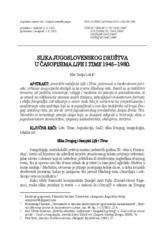Приказ основних података о документу
Slika jugoslovenskog društva u časopisima Life i Time, 1945-1980
The Image of Yugoslav Society in the Magazines Life and Time 1945–1980
| dc.creator | Lukić, Sanja | |
| dc.date.accessioned | 2024-02-23T14:11:10Z | |
| dc.date.available | 2024-02-23T14:11:10Z | |
| dc.date.issued | 2024 | |
| dc.identifier.issn | 0352-3160 | |
| dc.identifier.uri | http://reff.f.bg.ac.rs/handle/123456789/6211 | |
| dc.description.abstract | Američki nedeljnici Life i Time, pokrenuti u međuratnom periodu, vrhunac svog uspeha dostigli su za vreme Hladnog rata. Bavili su se različitim temama, od politike, ekonomije, religije i medicine do pitanja iz svakodnevnice, te su uticali na oblikovanje stavova svojih čitalaca, zahvaljujući inovativnom formatu i obilju fotografija. Istraživanje u ovom radu bilo je usmereno ka prepoznavanju i analiziranju niza sadržaja koji su se pojavljivali u ova dva nedeljnika od kraja Drugog svetskog rata, pa sve do smrti jugoslovenskog predsednika Josipa Broza Tita. Naročito se tematizuje pitanje uloge koju su časopisi odigrali u kreiranju slika o jugoslovenskom stanovništvu, njegovoj svakodnevnici, običajima, turizmu. | sr |
| dc.description.abstract | The representation of Yugoslavia and its populace in Life and Time magazines from the end of World War II until the rise of the Communist Party of Yugoslavia in 1945 and the subsequent death of President Josip Broz Tito in 1980 was characterized by fluctuations that aligned with the volatility of relations between Washington and Belgrade. The accession of the communist regime to power was viewed as a foreseeable outcome, as the population of this region of Europe, due to their impoverished and uneducated state, was believed to be ill-equipped to comprehend and embrace the concept of democracy. Consequently, individuals were selectively chosen to be depicted in a positive light when Yugoslavia was once again considered an ally following the conflict with the Cominform in 1948. Nevertheless, the representation of the Yugoslav people was brief and superficial, lacking in any true endeavor to demonstrate empathy for their situation and hardships. In spite of efforts to showcase certain favorable aspects, the representation of Yugoslavia that evolved over time in the magazines was predominantly consistent with the Cold War preconceptions that Americans associated with communism. This representation was infused with elements of nineteenth-century imperial Balkanism, indicating that Life and Time were disinclined to deviate far from the predetermined framework and societal roles assigned to them. | sr |
| dc.language.iso | sr | sr |
| dc.publisher | Institut za savremenu istoriju, Beograd | sr |
| dc.rights | openAccess | sr |
| dc.rights.uri | https://creativecommons.org/licenses/by/4.0/ | |
| dc.source | Istorija 20. veka | sr |
| dc.subject | Life | sr |
| dc.subject | Time | sr |
| dc.subject | Jugoslavija | sr |
| dc.subject | SAD | sr |
| dc.subject | slika Drugog | sr |
| dc.subject | imagologija | sr |
| dc.subject | Hladni rat | sr |
| dc.subject | Yugoslavia | sr |
| dc.subject | USA | sr |
| dc.subject | the image of Other | sr |
| dc.subject | imagology | sr |
| dc.subject | Cold War | sr |
| dc.title | Slika jugoslovenskog društva u časopisima Life i Time, 1945-1980 | sr |
| dc.title | The Image of Yugoslav Society in the Magazines Life and Time 1945–1980 | sr |
| dc.type | article | sr |
| dc.rights.license | BY | sr |
| dc.citation.epage | 198 | |
| dc.citation.issue | 1 | |
| dc.citation.rank | M23~ | |
| dc.citation.spage | 183 | |
| dc.identifier.doi | 10.29362/ist20veka.2024.1.luk.183-198 | |
| dc.identifier.fulltext | http://reff.f.bg.ac.rs/bitstream/id/15655/bitstream_15655.pdf | |
| dc.type.version | publishedVersion | sr |

